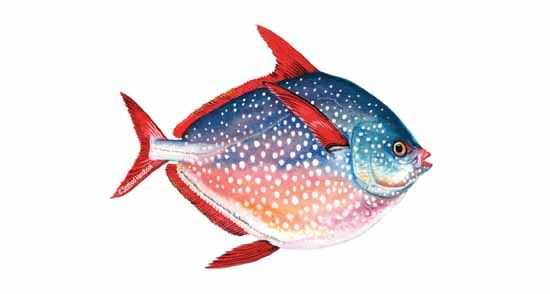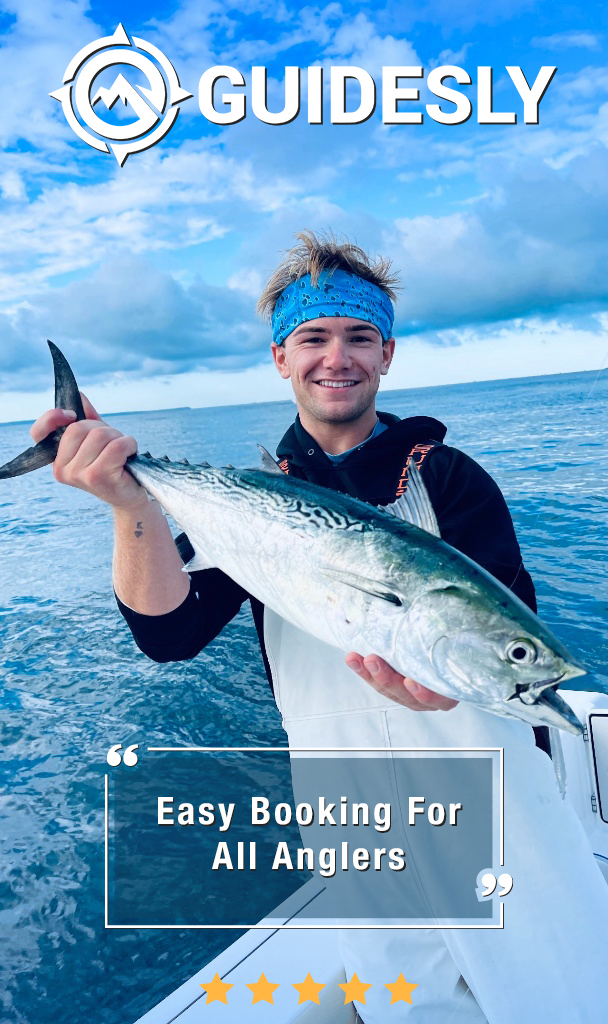Opah

Species Details
Lampris Guttatus
Lampridae
Lampriformes
Offshore
1 - 180 lbs.
1" - 79"
Opah (Lampris regius) Fish Description
The Opah (Lampris regius) is an unusual game fish found mostly in tropical and temperate waters around the world. Its flat and round body is silvery-grey on the sides that gradually darken on the top and lighten on the belly. Aside from its Frisbee-like body, what made the Opah more distinctive from other fishes in the ocean are its large eyes that are encircled with gold, its head and its pectoral, pelvic, dorsal, and caudal fins that are orangey red, as well as the white spots all over its body. Although the Opah is known to be a solitary fish and mostly lives in the deeper parts of the ocean, it sometimes schools with tunas and other scombrids such as mackerels and bonitos. It’s also a known carnivore that mainly preys on smaller fishes, squids, and crustaceans.
The most unusual thing about this fish is that it’s the only “true” warm-blooded fish species—meaning, it’s the only fish that can regulate its own body temperature. Yes, some fish species like tunas, marlins, and some sharks can temporarily make specific parts of their bodies warm, but only the Opah can warm its entire body. So even if it can still hunt for food in cold waters, it still has to return to the surface regularly to warm their heart, brain, and other vital organs.
Interesting Facts About Opahs
- The biggest Opah ever caught on record weighs over one hundred and eighty pounds.
- The 180-pounder Opah was caught by San Diego-based angler Joe Ludlow off a boat in the Mexican waters.
- Opahs can migrate over long distances for spawning, hunting for food, and looking for warmer environment conditions.
- Some call it moonfish because of its shape and color.
- Although they’re carnivorous, Opahs are toothless.
- Aside from humans, main predators of Opahs are big oceanic sharks such as Great Whites and Makos.
- Although its flesh has a light pink to orange color, it turns white when it’s cooked.
- Its flesh is rich in high-quality proteins and Omega-3 fatty acids.
- Its flesh may be tasty and healthy but only 35% of its body is consumable due to the thick skin and bones.
- Opah meat is highly valued in Hawaii.
- Most Opahs sold in the U.S. market are from Hawaii.
- Opahs spawn over wide areas in the Pacific—usually near the surface of the water where the temperatures are warmer.
- Female Opahs release their eggs while the males fertilize them.
Opah Average Speed and Size
Most Opahs that are caught are usually three feet in diameter and weighs about a hundred pounds; although a 180-pounder was caught in Mexican waters not so long ago. They are also not known to be fast and strong swimmers.
Where to Find Them - Habitat and Distribution
As earlier mentioned, Opahs can be found in pretty much all the oceans in the planet. They, however, stay mostly in the deeper parts and in the tropical and temperate waters.
Opah Fishing Tips
Okay, just because they can be found in most oceans around the world, they’re not picky eaters, they don’t swim particularly fast, and their fairly large population, you’re probably thinking Opahs must be pretty easy to catch. Well, yes, they’re easy to catch—that is if you find them.
Thing is, you rarely hear about anyone catching Opahs because 1), they like to live in isolation from other Opahs, and 2), the oceans of the world are huge! So the chances of you encountering one on your next fishing trip is pretty thin. In fact, Opahs rank as one of the rarest catch, especially for recreational fishers because this particular fish species, despite their sizable population, are scattered far and wide across the oceans.
If you’re specifically targeting Opahs on your next fishing trip, you should consider fishing on a boat and casting your line in the deeper parts of the ocean as Opahs normally hang out at 165 to 1,300 feet depths. Try to look for them near or within schools of tunas or mackerels as they are often seen swimming with them. You should also go Opah fishing when the weather is warm—specifically from July to October—as they’re known to swim closer to the shores within these months.
As for the gear, here are some of our recommendations:
- Rods: 7-foot medium to heavy-action conventional rods.
- Reels: Medium to heavy reels to be able to handle the fish’s size.
- Lines: 80-pound braid with 60-pound-test fluorocarbon top shot.
- Baits and rigs: Live or dead mackerels; fast-sinking 41⁄2-ounce jigs with bucktail hook, 61⁄2-ounce with a single hook, or 6-ounce braid with a treble hook.







